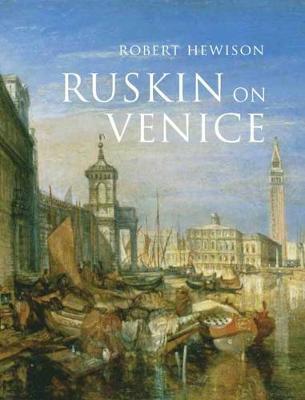This reading list is taken from Blue Guide Venice, 8th edition (2007). And Blue Guide Literary Companion Venice (2009) is an anthology of writing about or set in Venice:
The number of books that have been written about Venice is enormous. Ever since the first published descriptions of the city appeared in the 16th century, writers have been exploring her history, analysing her art and architecture, and using her as the backdrop for works of fiction. The list below gives some of the most recent publications, as well as seminal works of scholarship, or works of unique charm and vision, though these may be less readily available. Where relevant, first editions are given in square brackets, latest editions in rounded brackets.
General background
Paolo Barbaro, Venice Revealed, Souvenir Press (2002)
John Freely, Strolling Through Venice, Penguin (1994).
Christopher Hibbert, Venice: Biography of a City, [1988], Grafton (1990)
Hugh Honour, Companion Guide to Venice [1965], Companion Guides (2001)
Joe Links, Venice for Pleasure [1962], (2003)
Jan Morris, Venice [1960], Faber & Faber (1993)
History and Social history
David Chambers and Brian Pullan, Venice: a Documentary History 1450–1630, Blackwell (1992)
Charles Freeman, The Horses of St Mark’s, [2004], Abacus (2005)
Ralph A. Griffiths and John E. Law (ed.), Rawdon Brown and the Anglo-Venetian Relationship, Nonsuch Publishing (2005)
Jonathan Keates, The Siege of Venice, Vintage (2006)
Frederic C. Lane, Venice: A Maritime Republic, Johns Hopkins University Press (1973)
Mary MacCarthy, Venice Observed [1963]; The Stones of Florence and Venice Observed, Penguin (2006)
Jan Morris, The Venetian Empire: A Sea Voyage, Penguin (1990)
Francesco da Mosto, Francesco’s Italy, BBC Books (2004)
Jane da Mosto and Caroline Fletcher, The Science of Saving Venice, Umberto Allemandi
& Co (2004)
John Julius Norwich, Venice: The Rise to Empire, Alan Lane [1977], and Venice: The Greatness and the Fall, Viking [1981]; reissued as a single volume in paperback as The History of Venice, Penguin (2003)
John Julius Norwich, Paradise of Cities: Venice and its Nineteenth-century Visitors, Penguin (2004)
John Pemble, Venice Rediscovered, Oxford University Press (1996)
Bruce Redford, Venice and the Grand Tour, 1670–1830, Yale University Press (1996)
Margaret Plant, Venice: Fragile City 1797–1997, Yale University Press (2002).
Art history
J. Clegg, Ruskin and Venice, Junction Books (1981)
Ennio Concina, A History of Venetian Architecture, Cambridge University Press (1998)
Patricia Fortini Brown, The Renaissance in Venice (1997); Venice and Antiquity, Yale University Press (1997).
Richard Goy, Venice: the City and its Architecture, Phaidon (1999)
Julian Halsby, Venice. The Artist’s Vision [1990], UnicornPress (2002)
Robert Hewison, Ruskin and Venice, La Stamperia di Venezia (1983)
Paul Hills, Venetian Colour—marble, mosaic, and glass 1250–1550, Yale University Press (1999)
Deborah Howard, Venice and the East: The Impact of the Islamic World on Venetian
Architecture, Yale University Press (2000); The Architectural History of Venice[1980], Yale University Press (2005)
Peter Humfrey, Painting in Renaissance Venice, Yale University Press [1995], (2001)
Ralph Lieberman, Renaissance Architecture in Venice, Frederick Muller (1982)
Mary Lutyens (ed.) Effie in Venice: Effie Ruskin’s Letters Home 1849–1852[1965], Pallas
Athene (2003)
Margaret F. MacDonald, Palaces in the Night: Whistler in Venice, University of California
Press (2001)
Sarah Quill, Ruskin’s Venice. The Stones Revisited, Lund Humphries (2003)
John Ruskin, The Stones of Venice (3 vols) [1851], Pallas Athene (2003)
John Steer, Venetian Painting, Thames & Hudson [1970], (1991)
Arnold Whittick, Ruskin’s Venice (1976)
Literary works and poetry
Robert Browning, ‘A Toccata of Galuppi’s’
Lord Byron, ‘Childe Harold’s Pilgrimage’, ‘Marino Faliero’, ‘The Two Foscari’
Henry James, The Princess Casamassima [1886], The Aspern Papers [1888], The Wings of the Dove [1902]
Thomas Mann, Death in Venice [1913]
Hetty Meyric Hughes (ed.), Venice: Poetry of Place, Eland (2006)
Marcel Proust, Albertine Disparue [1925]
William Wordsworth, ‘On the Extinction of the Venetian Republic’
Modern fiction
Michael Dibdin, Dead Lagoon, Faber & Faber (1995)
L.P. Hartley, Eustace and Hilda [1947]
Donna Leon, crime novels set in Venice. The most recent include Through a Glass Darkly, (2006); Doctored Evidence, (2005); Wilful Behaviour, (2003); Death at La Fenice (2004)
Daphne du Maurier, ‘Don’t Look Now’ (short story in the collection Not After Midnight
[1971], famous as the basis for the Nicholas Roeg film of the same name)
Frederick Rolfe (Baron Corvo), The Desire and Pursuit of the Whole (1934)
Muriel Spark, Territorial Rights, Penguin [1979]
Emma Tennant, Felony, Vintage (2003)
Barry Unsworth, Stone Virgin [1985]
Salley Vickers, Miss Garnet’s Angel, HarperCollins (2001)
Modern non-fiction and anthologies
Milton Grundy, Venice. An Anthology Guide, Giles de la Mare Publishers (1998)
Ian Littlewood, A Literary Companion to Venice, St Martin’s Press (1995)
David C. McPherson, Shakespeare, Jonson and the Myth of Venice, University of Delaware Press (1990)
Michael Marqusee, Venice. An Illustrated Anthology, HarperCollins (1989)
Paula Weideger, Venetian Dreaming, Pocket Books (2004). A memoir of a year spent living in the Palazzo Donà delle Rose.
Some older histories and descriptions
Horatio Brown, Life on the Lagoons [1884]; Venice: An Historical Sketch [1895];In and Around Venice [1905], Studies in Venetian History [1907]
Shirley Guiton, No Magic Eden, Hamish Hamilton [1972], on Torcello, Burano, and Murano in particular, and A World by Itself:Tradition and Change in the Venetian Lagoon, Hamish Hamilton [1977], the sequel
William Dean Howells, Venetian Life [1866], Northwestern University Press (2001)
Edward Hutton, Venice and Venetia [1911]
Henry James, Italian Hours [1909], Kessinger (2004)
Logan Pearsall Smith (ed.), Life and Letters of Sir Henry Wotton, (2 vols); a vivid insight
into life in Venice in the early 17th century [1907]
E.V. Lucas, A Wanderer in Venice [1914], Indypublish (2005)
Pompeo Molmenti, Venice [1906]
Thomas Okey, Venice and its Story [1910]
Margaret Oliphant, The Makers of Venice [1898]
Lonsdale and Laura Ragg, Things Seen in Venice [1912]; Venice [1916]
Alexander Robertson, Venetian Sermons [1905], Kessinger (2004)
Margaret Symonds, Days Spent on a Doge’s Farm [1893]
Alethea Wiel, Venice [1894], Kessinger (2005)







